This article needs additional citations for verification .(June 2013) |
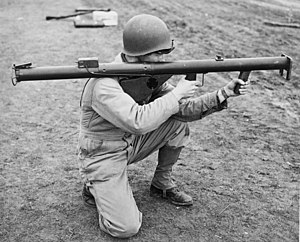
A rocket launcher is a weapon that launches an unguided, rocket-propelled projectile.
This article needs additional citations for verification .(June 2013) |

A rocket launcher is a weapon that launches an unguided, rocket-propelled projectile.

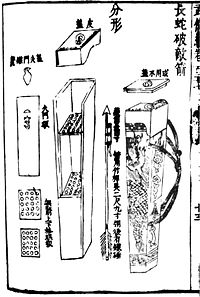
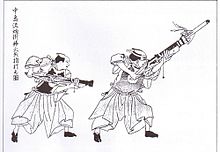
The earliest rocket launchers documented in imperial China consisted of arrows modified by the attachment of a rocket motor to the shaft a few inches behind the arrowhead. The rocket was propelled by the burning of the black powder in the motor; these should not be confused with early fire arrows, which were conventional arrows carrying small tubes of black powder as an incendiary that ignited only after the arrow hit its target. The rocket launchers were constructed of wood, basketry, and bamboo tubes. [1] The launchers divided the rockets with frames meant to keep them separated, and the launchers were capable of firing multiple rockets at once. Textual evidence and illustrations of various early rocket launchers are found in the 1510 edition of the Wujing Zongyao translated by Needham and others at Princeton University. (The original Wujing Zongyao was compiled between 1040 and 1044 and described the discovery of black powder but preceded the invention of the rocket. Partial copies of the original survived and Wujing Zongyao was republished in 1231 during the Southern Song Dynasty, including military developments since the original 1044 publication. The British scientist, sinologist, historian Joseph Needham asserts that the 1510 edition is the most reliable in its faithfulness to the original and 1231 versions, since it was printed from blocks that were re-carved directly from tracings of the edition made in 1231 AD.) The 1510 Wujing Zongyao describes the "long serpent" rocket launcher, a rocket launcher constructed of wood and carried with a wheelbarrow, and the "hundred tiger" rocket launcher, a rocket launcher made of wood and capable of firing 320 rocket arrows. [2] The text also describes a portable rocket carrier consisting of a sling and a bamboo tube. [3]
Rocket launchers known as "wasp nest" launchers were used by the Ming dynasty in 1380 and in 1400 by Li Jinglong against Zhu Di. [4]
Rockets were introduced to the West during the Napoleonic Wars; the Congreve rocket was a British weapon devised by Sir William Congreve in 1804 after experiencing Indian rockets at the Siege of Seringapatam (1799). Congreve rockets were launched from an iron trough about 18 inches (45 centimetres) in length, called a chamber. [5] These chambers could be fixed to the ground for horizontal launching, secured to a folding copper tripod for high angle fire or mounted on frames on carts or the decks of warships. [6]
The collection of the royal armies includes man portable rocket launchers that appear (based on lock designs) to date from the two decades after 1820. [7] These don't appear to have entered general use and no surviving documentation on them has been found. [7]
During the American Civil War, both the US and the Confederate militaries experimented upon and produced rocket launchers. [8] Confederate forces used Congreve rockets in limited uses due to its inaccuracies, while the US forces used Hale patent rocket launcher which fired seven to ten inch rockets with fin stabilizers at a range of 2,000 yards (6,000 ft).

Pre-war research programmes into military rocket technology by many of the major powers led to the introduction of a number of rocket artillery systems with fixed or mobile launchers, often capable of firing a number of rockets in a single salvo. In the United Kingdom, solid fuel rockets were initially used in the anti-aircraft role; the 7-inch Unrotated Projectile was fired from single pedestal-mounted launchers on warships and a 3-inch version was used by shore based Z Batteries, for which multiple "projectors" were developed. Later developments of these weapons included the Land Mattress multiple launchers for surface-to-surface bombardment and the RP-3 air-to-ground rockets that were launched from rails fitted to fighter bomber aircraft. In Germany, the 15 cm Nebelwerfer 41 was an adaptation of a multiple barrelled smoke mortar for artillery rockets. The Soviet 's Katyusha was a self-propelled system, being mounted on trucks, tanks and even trains. The United States Army deployed the tank mounted T34 Calliope system late in the war. [9]
The rocket launchers category includes shoulder-fired weapons, any weapon that fires a rocket-propelled projectile at a target yet is small enough to be carried by a single person and fired while held on one's shoulder. Depending on the country or region, people might use the terms "bazooka" or "RPG" as generalized terms to refer to such weapons, both of which are in fact specific types of rocket launchers. The Bazooka was an American anti-tank weapon which was in service from 1942 to 1957, while the RPG (most commonly the RPG-7) is a Soviet anti-tank weapon.
A smaller variation is the gyrojet, a small arms rocket launcher with ammunition slightly larger than that of a .45-caliber pistol.
Recoilless rifles are sometimes confused with rocket launchers. A recoilless rifle launches its projectile using an explosive powder charge, not a rocket engine, though some such systems have sustainer rocket motors.

A rocket pod is a launcher that contains several unguided rockets held in individual tubes, designed to be used by attack aircraft or attack helicopters for close air support. In many cases, rocket pods are streamlined to reduce aerodynamic drag. The first pods were developed immediately after World War II, as an improvement over the previous arrangement of firing rockets from rails, racks or tubes fixed under the wings of aircraft. Early examples of pod-launched rockets were the US Folding-Fin Aerial Rocket and the French SNEB. [10]
Larger-scale devices which serve to launch rockets include the multiple rocket launcher, a type of unguided rocket artillery system.

A missile is an airborne ranged weapon capable of self-propelled flight aided usually by a propellant, jet engine or rocket motor.
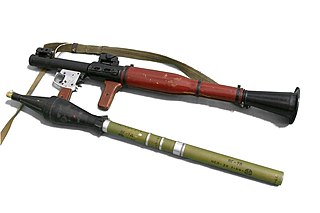
A rocket-propelled grenade (RPG) is a shoulder-fired rocket weapon that launches rockets equipped with an explosive warhead. Most RPGs can be carried by an individual soldier, and are frequently used as anti-tank weapons. These warheads are affixed to a rocket motor which propels the RPG towards the target and they are stabilized in flight with fins. Some types of RPG are reloadable with new rocket-propelled grenades, while others are single-use. RPGs are generally loaded from the front.

A recoilless rifle (rifled), recoilless launcher (smoothbore), or simply recoilless gun, sometimes abbreviated to "RR" or "RCL" is a type of lightweight artillery system or man-portable launcher that is designed to eject some form of countermass such as propellant gas from the rear of the weapon at the moment of firing, creating forward thrust that counteracts most of the weapon's recoil. This allows for the elimination of much of the heavy and bulky recoil-counteracting equipment of a conventional cannon as well as a thinner-walled barrel, and thus the launch of a relatively large projectile from a platform that would not be capable of handling the weight or recoil of a conventional gun of the same size. Technically, only devices that use spin-stabilized projectiles fired from a rifled barrel are recoilless rifles, while smoothbore variants are recoilless guns. This distinction is often lost, and both are often called recoilless rifles.
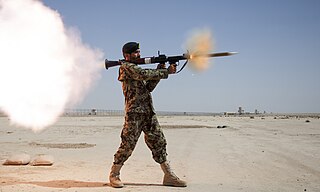
Shoulder-fired missile, shoulder-launched missile or man-portable missile, among other variants, are common slang-terms to describe high-caliber shoulder-mounted weapons systems – that is: weapons firing large heavy projectiles ("missiles"), typically using the backblast principle, which are small enough to be carried by a single person and fired while held on one's shoulder. The word "missile" in this context is used in its original broad sense of a heavy projectile, and encompasses all shells and rockets, guided or unguided. A more formal variant is simply shoulder-fired weapons system and the like.

A multiple rocket launcher (MRL) or multiple launch rocket system (MLRS) is a type of rocket artillery system that contains multiple launchers which are fixed to a single platform, and shoots its rocket ordnance in a fashion similar to a volley gun. Rockets are self-propelled in flight and have different capabilities than conventional artillery shells, such as longer effective range, lower recoil, typically considerably higher payload than a similarly sized gun artillery platform, or even carrying multiple warheads.

A ranged weapon is any weapon that can engage targets beyond hand-to-hand distance, i.e. at distances greater than the physical reach of the user holding the weapon itself. The act of using such a weapon is also known as shooting. It is sometimes also called projectile weapon or missile weapon because it typically works by launching solid projectiles ("missiles"), though technically a fluid-projector and a directed-energy weapon are also ranged weapons. In contrast, a weapon intended to be used in hand-to-hand combat is called a melee weapon.
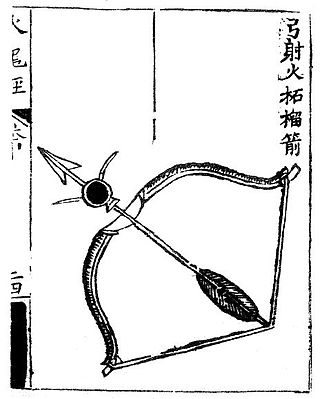
Fire arrows were one of the earliest forms of weaponized gunpowder, being used from the 9th century onward. Not to be confused with earlier incendiary arrow projectiles, the fire arrow was a gunpowder weapon which receives its name from the translated Chinese term huǒjiàn (火箭), which literally means fire arrow. In China a 'fire arrow' referred to a gunpowder projectile consisting of a bag of incendiary gunpowder attached to the shaft of an arrow. Fire arrows are the predecessors of fire lances, the first firearm.

Rocket artillery is artillery that uses rockets as the projectile. The use of rocket artillery dates back to medieval China where devices such as fire arrows were used. Fire arrows were also used in multiple launch systems and transported via carts. The first true rocket artillery was developed in South Asia by the Tipu Sultan the ruler of the Kingdom of Mysore. In the late nineteenth century, due to improvements in the power and range of conventional artillery, the use of early military rockets declined; they were finally used on a small scale by both sides during the American Civil War. Modern rocket artillery was first employed during World War II, in the form of the German Nebelwerfer family of rocket ordnance designs, Soviet Katyusha-series and numerous other systems employed on a smaller scale by the Western allies and Japan. In modern use, the rockets are often guided by an internal guiding system or GPS in order to maintain accuracy.

The Huolongjing, also known as Huoqitu, is a Chinese military treatise compiled and edited by Jiao Yu and Liu Bowen of the early Ming dynasty (1368–1683) during the 14th century. The Huolongjing is primarily based on the text known as Huolong Shenqi Tufa, which no longer exists.
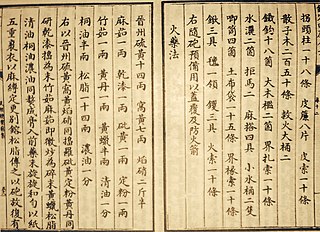
The Wujing Zongyao, sometimes rendered in English as the Complete Essentials for the Military Classics, is a Chinese military compendium written from around 1040 to 1044.

Gunpowder is the first explosive to have been developed. Popularly listed as one of the "Four Great Inventions" of China, it was invented during the late Tang dynasty while the earliest recorded chemical formula for gunpowder dates to the Song dynasty. Knowledge of gunpowder spread rapidly throughout Asia and Europe, possibly as a result of the Mongol conquests during the 13th century, with written formulas for it appearing in the Middle East between 1240 and 1280 in a treatise by Hasan al-Rammah, and in Europe by 1267 in the Opus Majus by Roger Bacon. It was employed in warfare to some effect from at least the 10th century in weapons such as fire arrows, bombs, and the fire lance before the appearance of the gun in the 13th century. While the fire lance was eventually supplanted by the gun, other gunpowder weapons such as rockets and fire arrows continued to see use in China, Korea, India, and this eventually led to its use in the Middle East, Europe, and Africa. Bombs too never ceased to develop and continued to progress into the modern day as grenades, mines, and other explosive implements. Gunpowder has also been used for non-military purposes such as fireworks for entertainment, or in explosives for mining and tunneling.
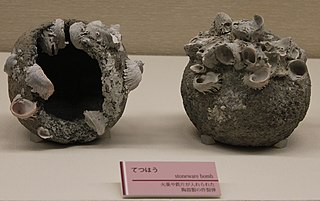
The thunder crash bomb, also known as the heaven-shaking-thunder bomb, was one of the first bombs or hand grenades in the history of gunpowder warfare. It was developed in the 12th-13th century Song and Jin dynasties. Its shell was made of cast iron and filled with gunpowder. The length of the fuse could be adjusted according to the intended throwing distance.

The first rockets were used as propulsion systems for arrows, and may have appeared as early as the 10th century in Song dynasty China. However more solid documentary evidence does not appear until the 13th century. The technology probably spread across Eurasia in the wake of the Mongol invasions of the mid-13th century. Usage of rockets as weapons before modern rocketry is attested to in China, Korea, India, and Europe. One of the first recorded rocket launchers is the "wasp nest" fire arrow launcher produced by the Ming dynasty in 1380. In Europe rockets were also used in the same year at the Battle of Chioggia. The Joseon kingdom of Korea used a type of mobile multiple rocket launcher known as the "Munjong Hwacha" by 1451.

A gun is a device designed to propel a projectile using pressure or explosive force. The projectiles are typically solid, but can also be pressurized liquid, or gas. Solid projectiles may be free-flying or tethered. A large-caliber gun is also called a cannon.

In military terminology, a rocket is a self-propelled, unguided or guided, weapon-system powered by a rocket engine. Though used primarily as medium- and long-range artillery systems, historically rockets have also seen considerable use as air-to-surface weapons, some use as air-to-air weapons, and even as surface-to-air devices. Examples of modern surface-to-surface rocket systems include the Soviet BM-27 Uragan and the American M270 Multiple Launch Rocket System.
Gunpowder weapons in the Song dynasty included fire arrows, gunpowder lit flamethrowers, soft shell bombs, hard shell iron bombs, fire lances, and possibly early cannons known as "eruptors". The eruptors, such as the "multiple bullets magazine eruptors", consisting of a tube of bronze or cast iron that was filled with about 100 lead balls, and the "flying-cloud thunderclap eruptor", were early cast-iron proto-cannons that did not include single shots that occluded the barrel. The use of proto-cannon, and other gunpowder weapons, enabled the Song dynasty to ward off its generally militarily superior enemies—the Khitan led Liao, Tangut led Western Xia, and Jurchen led Jin—until its final collapse under the onslaught of the Mongol forces of Kublai Khan and his Yuan dynasty in the late 13th century.

Man-portable anti-tank systems are traditionally portable shoulder-launched projectile systems firing heavy shell-type projectiles, typically designed to combat protected targets, such as armoured vehicles, field fortifications and at times even low-flying aircraft.
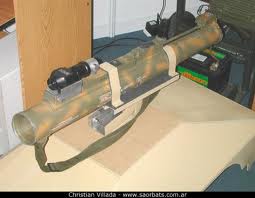
The MARA is a portable one-shot 78 mm unguided anti-tank weapon, designed and manufactured in Argentina by Fabricaciones Militares (DGFM). The solid rocket propulsion unit was developed by CITEFA.
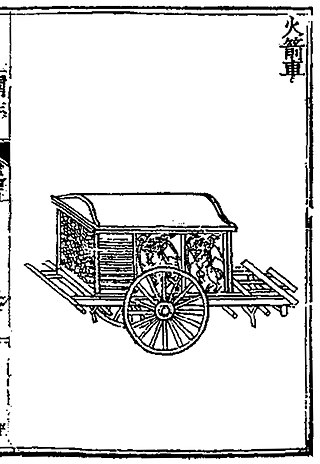
Huo Che or rocket carts are several types of Chinese multiple rocket launcher developed for firing multiple fire arrows. The name Huo Che first appears in Feng Tian Jing Nan Ji, a historical text covering the Jingnan War of Ming dynasty.
This is a timeline of the history of gunpowder and related topics such as weapons, warfare, and industrial applications. The timeline covers the history of gunpowder from the first hints of its origin as a Taoist alchemical product in China until its replacement by smokeless powder in the late 19th century.